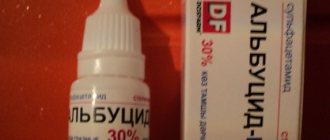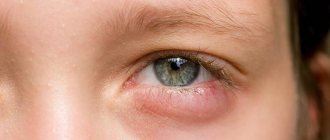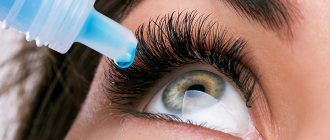The health of the expectant mother must be impeccable, and during pregnancy this is a top priority. To maintain your health and treat diseases, you need to be as careful and attentive as possible to yourself and the medications you use.
What do the instructions for Albucid eye drops say during pregnancy? What are the possible negative consequences, and how to apply them correctly so as not to harm yourself and your child? These and other questions should be asked by any expectant mother before starting treatment.
"Sulfacetamide" for the treatment of the nasal passages
Respiratory diseases are accompanied by green or yellowish mucous discharge. The above syndromes are actively relieved with the help of Sulfacyl Sodium. Nasal drops during pregnancy are prescribed for the treatment of purulent discharge and rhinitis. The aqueous solution dries and reduces the amount of mucus from the nose, making breathing easier.
The product will be ineffective in diagnosing pathologies caused by dangerous bacterial pathogens, such as pneumococcus, Haemophilus influenzae, and staphylococcus.
Untimely and incorrect treatment contributes to the development of sinusitis, sinusitis, and tonsillitis.
The use of a pharmacological substance does not exclude the feeling of burning, dry nasopharynx, itching
The medication is allowed for use in all trimesters of pregnancy. Clinical testing and studies of patterns of phenomena have proven safety and the absence of negative consequences of using the drug, because active components do not pose a threat to the health of the mother and fetus.
An aqueous solution causes virtually no adverse reactions. Patients with an allergic reaction to the constituent components are at risk. Whether Sulfacyl Sodium can be taken during pregnancy is determined by the attending physician, taking into account the individual characteristics of the body and the nature of the pathology.
Contraindications
Albucid is contraindicated if there is an individual intolerance or an allergic reaction to one of the components of the drug.
In the third trimester of pregnancy, if there are disturbances in the functioning of the liver, increased sensitivity to the active substance, as well as disturbances in the functioning of the excretory system, the drops are taken only after consulting a doctor. It is not recommended to take Albucid with other drugs similar in action, in order to avoid a decrease in the therapeutic effect. It is contraindicated to simultaneously use drugs that contain silver salts.
Side effects of Albucid
Slight pain in the first minutes after use is a normal reaction.
If you use the drug in accordance with the instructions and individual prescriptions of the attending physician, then side effects appear only in rare cases.
Negative manifestations of the use of the drug often occur with long-term use. The following side effects are identified:
- Burning inside the eyeball;
- Redness of the eyelids around the eye;
- Swelling;
- Constant itching.
Do not lose sight of the fact that the drops themselves bring painful sensations in the first moments after instillation. If such symptoms do not go away within the first minutes, then you should think about changing the drug.
Any manifestation of side effects indicates the need to stop treatment and consult a doctor. Only the doctor makes a decision on a possible replacement of the drug.
Irrigation of the nasal mucosa with Sulfacyl Sodium
Before carrying out therapeutic manipulations, it is recommended to rinse the nasal sinuses with saline solution. The course of treatment does not exceed 7 days, during which a drug containing 30% salfacetamide is instilled 3-4 times a day, 2 drops into each opening of the nose.
The antimicrobial drug is intended to relieve inflammatory processes of the eye apparatus and respiratory organs. Among the advantages of the medicinal product are high efficiency and safety of use, even during pregnancy and breastfeeding.
The choice in favor of the drug is supported by the general availability of the drug (available without a prescription) and the low price range (from 70 to 100 rubles).
For topical use only. Cannot be injected.
Rarely, deaths have been reported due to severe reactions to sulfonamides, including Stevens-Johnson syndrome, toxic epidermal necrolysis, fulminant hepatonecrosis, agranulocytosis, aplastic anemia and other pathological changes in the blood system.
Sensitization to sulfonamides may occur with repeated use, regardless of the route of administration. Sensitization to sulfonamides has been observed in people with no history of hypersensitivity to sulfonamides. If the first signs of hypersensitivity, skin rash or other serious adverse reactions appear, the use of the drug should be discontinued.
Patients with hypersensitivity to furosemide, thiazide diuretics (hydrochlorothiazide), sulfonylureas (glibenclamide) or carbonic anhydrase inhibitors (diacarb) may have increased sensitivity to sulfacyl.
Excessive growth of microorganisms that are insensitive to sulfacetamide, as well as fungal flora, is possible.
The antibacterial activity of the drug is reduced in the presence of high concentrations of para-aminobenzoic acid in the presence of a large amount of purulent discharge.
It is necessary to stop therapy if allergy symptoms appear, as well as if pain and other signs of an infectious-inflammatory process increase, or the amount of purulent discharge increases.
Children. This dosage form is not used in children.
Use during pregnancy and lactation
It is unknown what effect sodium sulfacyl may have on the fetus. It is not recommended to use sodium sulfacyl for pregnant women without consulting a doctor. It is not known whether sodium sulfacyl passes into breast milk. It is not recommended to use sodium sulfacyl for nursing mothers without consulting a doctor.
Impact on the ability to drive vehicles and other potentially dangerous mechanisms
Use caution when driving, operating industrial equipment, or performing other hazardous work. Sulfacyl sodium may cause blurred vision. If you experience blurred vision, avoid hazardous activities.
Albucid during pregnancy - reviews on the use of drops
Practical experience of using Albucid during pregnancy, according to reviews from women who have already given birth, has not shown a negative effect of the drug on the development of the child and the course of pregnancy. It is worth noting that treatment was carried out mainly in the second and third trimesters of gestation. Short-term eye drops at earlier stages also did not provoke negative consequences. The drops are made even more attractive by their low cost (about 40 rubles per 10 ml bottle).
- Maria: “At 16 weeks, the eye began to water and purulent discharge appeared. The doctor prescribed Albucid. It dripped for 3 days, but there was no improvement. As the doctor said, many bacteria have developed resistance to sulfacetamide. The drug has been replaced."
Anna: “I used the drops for a week at 37 weeks. The inflammation quickly subsided. I didn’t notice any negative reactions.”
Albucid during pregnancy
Albucid drops are not an antibiotic, but have pronounced antimicrobial activity. Drugs of this type always cause concern among expectant mothers. Will the components of the drops harm a developing baby?
Albucid during pregnancy 1st trimester
During the first weeks of gestation, the expectant mother is especially attentive and sensitive to her health. However, even in this case, it is not always possible to avoid various infectious diseases. Once on the mucous membrane of the eyelid, the drug is practically not absorbed. When instilling the product into the nasal passages, the systemic presence of the active substance will be slightly greater. The instructions for the drug do not indicate pregnancy as a contraindication to the use of drops. This means that even in the first trimester of expecting a baby, the use of Albucid is possible, but only as prescribed by a doctor. The use of Albucid for the treatment of the nose in early pregnancy is not recommended. There are other drugs in this area, the use of which is permitted from the first weeks of gestation.
Albucid during pregnancy 3rd trimester
Infectious and inflammatory eye lesions can occur at any time during the pregnancy. If the disease attacks in the third trimester of gestation, the expectant mother can use Albucid without much concern. This is due to the fact that, firstly, by this period the baby is fully formed, which excludes the occurrence of malformations as a result of exposure to sulfacetamide. Secondly, the active substance practically does not enter the bloodstream, so it is not capable of harming the baby.
Rules for using eye drops during pregnancy
To use eye drops during pregnancy and get the desired results from them, you need to follow several recommendations.
- Only a doctor should prescribe medicine after examination. An important point is the correct selection of eye drops that are allowed at the time of pregnancy.
- In the first twelve weeks, you should not use drops that contain carbonic anhydrase and blockers, since if they penetrate into the blood, they can have an adverse effect on the development of the baby.
- In the second trimester, blockers and other types of eye drops can be used, but under the strict supervision of a doctor.
- In the last ten weeks, it is better not to use any eye products at all, as there is a possibility of suppression of the nervous system of the unborn baby.
- The drug must be instilled correctly. Doctors advise closing your eyes for a few minutes after use. If the inflammatory process is observed in both eyes, then the product should be instilled alternately after ten minutes so as not to exceed the concentration of substances entering the blood.
- All eye drops have an expiration date. Once opened, they should be stored in the refrigerator for no more than thirty days. After this, throw away the bottle, even if there are remains of the medicine.
- All pregnant women should visit an ophthalmologist more often and have their intraocular pressure measured.
- If dry eye syndrome occurs during pregnancy, it is allowed to use moisturizing drops in the form of Visine, Oksial, Oftolic and Vidisica.
Any drug has a number of contraindications and side effects when used. Therefore, if an inflammatory process in the eyes occurs during pregnancy, then you should urgently consult a doctor. After all, eye drops during pregnancy can be replaced with traditional methods of treatment. This includes lotions with herbal infusion, brewing black or green tea, or simply using saline solution.
When is Albucid prescribed to pregnant women?
Despite the fact that the drug mainly has a local effect, that is, it penetrates the tissue at the site of application and eliminates the inflammatory process, part of the composition still enters the systemic bloodstream. This is important for some patient groups. This also includes pregnant women, who need to especially carefully monitor the exact composition of the medications used, and whether they have any contraindications due to this.
In addition, pregnancy itself is a stress on the body, when all systems work in enhanced mode. For this reason, various problems that were previously rare in women are now more likely. In particular, pregnant women often suffer from conjunctivitis, and it is extremely difficult to achieve a complete cure for this group of patients. Typically, this pathology is the most common reason for prescribing Albucid to a pregnant woman. The drug can also be prescribed for other ophthalmological diseases associated with the entry and activation of a bacterial infection in the tissues of the organ of vision.
But Albucid has another indication during pregnancy - sinusitis, or runny nose. In view of the relative safety of the drug during this important period for a woman’s life, the appointment of Albucid is completely justified, and it will bring cherished relief. Moreover, it will help treat even prolonged chronic runny nose. But this does not mean that you need to start using it yourself at the first unpleasant signs in the nasal cavity. Any use of pharmaceuticals during this period must be previously agreed upon with the attending physician.
Use of the drug
Is it possible to take Albucid during pregnancy? itself is not a contraindication . This is a proven drug that is instilled into the eyes of even newborn children. If the body’s reaction to medications from the sulfonamide group and individual intolerance to other components have not previously been noticed, you can confidently take Albucid.
Despite the free sale of the drug without a prescription, it should only be used after consulting a doctor. An excess of the active substance can lead to unpleasant reactions in the body, in particular:
- burning;
- itching;
- redness of the eyes;
- increased lacrimation;
- swelling.
If these symptoms occur, you should immediately see a specialist and stop using Albucid.
Features of application
For ophthalmological diseases, the drug is used topically, that is, a couple of drops are instilled into the conjunctival sac. This procedure must be carried out for both eyes, even if there is obvious inflammation in only one. The fact is that the spread of infection in such diseases occurs very quickly and unnoticed by the patient. The frequency of use can be up to 6 times a day, but in any case it is individual and is discussed by the doctor during a consultation after examining the patient. In case of persistent improvement, the daily frequency of administration can be reduced to three times a day.
If a pregnant woman uses contact lenses, then during treatment with Albucid her visual acuity will have to be corrected using non-contact means - glasses. This is due to the fact that the composition of Albucid negatively affects the lens material and changes their transparency.
In addition, lenses do not allow the composition of the medicinal product to come into full contact with the tissues of the eye, and, consequently, the therapeutic course is delayed.
For a runny nose in pregnant women, the drug is used as follows. The product should be dripped 2 drops into each nostril three times a day, at equal intervals. The duration of treatment is individual, usually it ranges from 1 week to 10 days.
Description of Albucid
Albucid is an antibiotic that, when applied topically, penetrates well into all parts, fluids and tissues of the eye, and in case of severe local inflammation, it can be absorbed into the systemic bloodstream. If large amounts of medicine enter the bloodstream, it may cause some side effects.
The effect of the drug is due to disruption of the formation of amino acids in the bacterial cell, which leads to the cessation of reproduction of a wide range of pathogenic microorganisms. This property makes this drug an excellent remedy for the treatment of conjunctivitis. Just like Oftalmoferon drops, it quickly copes with this disease.
About the drug
Albucid is a topical antibacterial drug widely used in treatment. It has a wide range of actions with a bacteriostatic effect directed against microbes that cause inflammatory processes. Sulfacyl sodium acts as the main active ingredient.
Has activity against gram-negative and gram-positive bacteria. The peculiarity of local application is the penetration of the drug into tissues with subsequent absorption into the systemic bloodstream.
It is important to monitor the concentration of the active substance in the drug. Albucid comes in: 10%, 20% and 30%.
The effect of the drug on the fetus
It is necessary to understand the mechanism of the effect of the composition of the product on the development of the baby, so as not to harm the baby in the womb. This mechanism differs at different periods of pregnancy.
In the 1st trimester
In the first three months of pregnancy, the main formation of all organs and systems occurs. Exposure to any pharmaceutical drugs during this period is extremely undesirable, since it can change the normal natural development and subsequently cause pathology in the baby. For this reason, doctors pay special attention to pregnant women and try not to prescribe drugs if it is possible to be cured without their help. The same goes for Albucid. Most likely, the attending physician will first prescribe the patient auxiliary remedies, including traditional recipes, and only if the situation worsens will he advise resorting to the help of chemicals.
In the 2nd and 3rd trimester
The laying of the baby's organs by the second trimester of pregnancy has already passed. Now their intensive development begins, the baby is actively growing and gaining weight. This period is considered relatively safe for the use of various pharmaceutical drugs, and therefore Albucid is prescribed without fear if necessary. Of course, the expectant mother must strictly follow the specialist’s recommendations and adhere to the therapeutic regimen prescribed by him.
In later stages of pregnancy, the use of Albucid will not harm the baby in the womb, and therefore it may well be prescribed if necessary.
But here another problem appears. For many pregnant women, various problems begin and worsen by this time. In particular, the functioning of the liver and excretory system very often malfunctions, but it is these organs that are responsible for the release of substances from the body. Prescribing Albucid may further aggravate existing problems.
Use with other medicines
It is not recommended to administer Albucid together with other medications. In this case, its effect may be significantly reduced, because of this the desired result will occur later than expected.
If combining medications cannot be avoided, then be sure to inform your doctor about all medications you are currently taking.
Thus, Albucid is not only a remedy for the treatment of diseases associated with the organs of vision, but also helps in the fight against runny nose of an infectious nature. Pregnancy is not a ban on using the medication.
On the contrary, therapists in most cases prescribe it for its wide spectrum of action and lack of influence on the developing fetus. It is recommended to use the drug only as prescribed by a doctor.
It is safe and approved for use during pregnancy and lactation, as well as in young children.
However, it is worth remembering that albucid has only a bacteriostatic effect, that is, if after using albucid for several days the symptoms do not go away or even intensify, a stronger antibacterial drug with a bacteriolytic effect may need to be prescribed.
We invite you to watch an interesting video about conjunctivitis:
Noticed a mistake? Select it and press Ctrl+Enter to let us know.
Indications for use
The drug has an effect on inflammatory diseases caused by staphylococci, streptococci, chlamydia, actinomycetes, gonococci and other pathogens. It has the following indications for use:
- keratitis;
- barley;
- conjunctivitis of bacterial nature;
- blenorrhea;
- blepharitis;
- injury to the tissues of the cornea;
- otitis;
- persistent rhinitis.
The drug is prescribed to pregnant women both for lesions of the conjunctiva itself, and in the case of inflammation of the eyelids, when diagnosing purulent ulcerations of the cornea.
Albucid can also be instilled into the nose for prolonged rhinitis, which is caused by the spread of bacterial flora.
Although the medicine is relatively safe, it can only be used as prescribed by a doctor.
Treatment of ophthalmic pathologies should be carried out under the supervision of an ophthalmologist. The standard treatment regimen for the inflammatory process involves installations up to 6 p.m. throughout the day, one application will require 3 drops. medications. The time interval between installations is 4 hours.
If a visible therapeutic effect is observed, the dosage of the drug can be reduced. Duration of therapy – 7 days.
The drug can be instilled not only into the eyes, but also into the nasal passages with green purulent discharge in order to eliminate inflammation and neutralize bacterial flora. Before instilling the drug, it is necessary to clear the nasal passages of secretions. Typically, 0.9% saline solution or boiled water with the addition of sea salt is used to rinse the nose.
How to pre-clean your nose:
- While lying down, tilt your head to the side, then drip saline or saline into the opposite nostril
- The same procedure is carried out with the second nasal passage
- You need to stand up and exhale sharply to clear your nose of accumulated secretions.
During pregnancy, Albucid is dripped into the nose twice a day, 2 drops. After instilling the medicine, you need to lie down for a while so that the medicine penetrates into the nasal sinuses.
Usually the drug is prescribed for a runny nose for 10-14 days. But it is also possible to extend treatment until the symptoms of the disease completely disappear.
Prescription of the drug during pregnancy
Albucid is prescribed during pregnancy to combat the following problems:
- Keratitis.
- Blepharitis.
- Otitis.
- Conjunctivitis.
- Corneal ulcer.
- Prolonged rhinitis.
- Gonorrheal disease of the organs of vision.
In addition to all these diseases, a specialist may recommend Albucid in the nose during pregnancy. The main indications for use concern the eyes, but this drug can also help with a runny nose. When carrying a child, based on the symptoms, the attending physician chooses a course of treatment.
In acute cases of the disease, a specialist can prescribe up to 3 drops 6 times a day . As soon as the symptoms subside, the number of instillations is reduced. The course of treatment often does not exceed 1 week. Separately, it is worth noting that Albucid can still be instilled into the ears; detailed information is here.
Albucid for a runny nose
This drug can be prescribed by a doctor for a runny nose, but there is no need to use the drug at the initial stage of development of a runny nose; for these purposes, other remedies will be more relevant. The effectiveness of treatment can only be achieved with chronic and prolonged rhinitis, which was caused by a bacterial infection.
Before starting the procedure, you need to properly prepare your nose, clean it of secretions using saline solutions and other means. Adults are advised to take 2-3 drops, up to 4 times a day. The procedures must be completed within two weeks.
It is important to strictly follow all doctor’s recommendations and not exceed the dosage.
If the cause of rhinitis is a virus, this remedy is not prescribed. The main indication for the use of Albucid in the nose is long-term rhinitis, which was caused by a bacterial infection entering the body. It can be easily distinguished by 4 main characteristics:
- mucus may be released from the nasal cavity, which is accompanied by an unpleasant odor;
- long course of the pathological process;
- the discharge may have a yellowish or green tint;
- all classical remedies for rhinitis are powerless.
Albucid eye drops: analogues
It is not for nothing that Albucid is very popular among patients: its cost is “penny”, and its effectiveness is high. There are many analogues in the pharmacy kiosk that have the same pharmacological properties, but their cost can be several times higher.
Albucid eye drops (analogues):
At the first signs of an inflammatory process in the eye membrane, you need to contact an ophthalmologist or therapist (if a child is sick, then you can also see a pediatrician) to choose the right treatment.
The use of various traditional medicine methods in many cases does not help cope with the disease.
Remember! Self-medication can negatively affect your health!
- Albucid reviews for runny nose
- Albucid in the nose of a 2 year old child
Albucid eye drops during pregnancy
Albucid is a drug that belongs to the antibacterial drugs from the sulfonamide group. It is produced in the form of eye drops and is used for various infectious and inflammatory diseases of the eye organs (blepharitis, conjunctivitis, keratitis, purulent corneal ulcers, etc.). However, you can often hear that ENT doctors prescribe Albucid drops into the nose. Whether this prescription is correct, how much Albucid should be dripped into the nose, and how this drug works when used in this way, we will consider further.
Pharmacological action of Albucid
Sulfacyl sodium has a wide spectrum of antimicrobial action, namely, it is active against the following types of microorganisms:
- streptococci;
- staphylococci;
- gonococci;
- pneumococci;
- shigella;
- coli;
- Vibrio cholerae;
- anthrax pathogen;
- causative agent of diphtheria;
- chlamydia;
- actinomycetes;
- toxoplasma, etc. The drug acts bacteriostatically, i.e. influences the processes of growth and reproduction of pathogenic microorganisms, thereby, in conjunction with the protective mechanisms of the immune system, gradually causing their death. Albucid, when applied topically, is absorbed into the systemic circulation in small quantities.
Application of Albucid in the nose
Albucid drops are not the only ophthalmic drug that experienced otolaryngologists prescribe for a runny nose. In fact, antibacterial eye drops are effective for rhinitis caused by various types of bacteria. The spectrum of action of Albucid includes those types of microbes that most often cause bacterial rhinitis. For viral infections, this remedy is ineffective.
How to distinguish a bacterial runny nose from a viral one? The main signs of rhinitis. caused by bacteria are:
For what conditions is it prescribed?
This is what eye conjunctivitis looks like
The instructions highlight the following indications for use on a general basis:
- Conjunctivitis - profuse redness and slight swelling of the eyelids appear. Abundant mucous and purulent discharge appears from the conjunctival sac. There may be a feeling of “sand in the eyes”, expressed by dryness, a desire to scratch;
- Blepharitis – inflammation of the sebaceous glands along the edge of eyelash growth forms;
- Gonorrheal eye disease - if the rules of personal hygiene are not observed, if there is gonorrhea of the genitals, it is possible to introduce infection into the eyes with dirty hands. Signs of the disease are identical to those of conjunctivitis;
- Keratitis is expressed by inflammation in the layers of the cornea. The latter becomes clouded, and the lens ceases to clearly transmit information about the surrounding world;
- Corneal ulcer – severe cutting pain, excessive lacrimation, and the cornea becomes cloudy. During the healing process, a scar forms on the eye and photophobia develops.
In addition, qualified specialists can prescribe for prolonged otitis media or long-term rhinitis. Although the medicine is a means for treating the organs of vision, its spectrum of action also extends to the area of ENT diseases.











